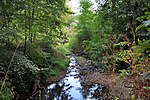River View Cemetery (Portland, Oregon)
1882 establishments in OregonCemeteries in Portland, OregonSource attributionSouthwest Portland, Oregon

River View Cemetery is a non-profit cemetery located in the southwest section of Portland, Oregon. Founded in 1882, it is the final resting place of many prominent and notable citizens of Oregon, including many governors and members of the United States Senate. Other notable burials include Henry Weinhard's family, W.A.S.P Pilot Hazel Ying Lee, football player Lyle Alzado, baseball layer Carl Mays, and famous western lawman Virgil Earp.
Excerpt from the Wikipedia article River View Cemetery (Portland, Oregon) (License: CC BY-SA 3.0, Authors, Images).River View Cemetery (Portland, Oregon)
South Taylors Ferry Road, Portland South Burlingame
Geographical coordinates (GPS) Address Nearby Places Show on map
Geographical coordinates (GPS)
| Latitude | Longitude |
|---|---|
| N 45.465 ° | E -122.673 ° |
Address
South Taylors Ferry Road 300
97219 Portland, South Burlingame
Oregon, United States
Open on Google Maps










